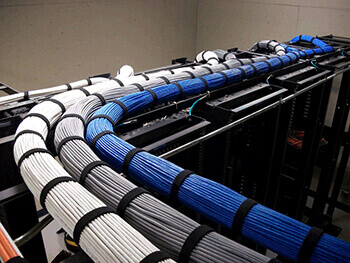Structured Cabling
For today's businesses, the consistently reliable distribution of information is necessary, whether it’s transmitted by voice, computer, video, or other electronic media. Structured cabling carries an organization’s most critical information from one source to another.
 Structured cabling is often defined as the design and installation of cabling systems that support multiple forms of data transmission. When done properly, structured cabling contemplates both current and future needs, so an organization’s infrastructure can handle growth at any rate. Structured cabling design and installation often includes proper grounding and bonding, firestopping, and cable support hardware.
Structured cabling is often defined as the design and installation of cabling systems that support multiple forms of data transmission. When done properly, structured cabling contemplates both current and future needs, so an organization’s infrastructure can handle growth at any rate. Structured cabling design and installation often includes proper grounding and bonding, firestopping, and cable support hardware.
The technicians at Gibson Electric understand the vital role that communication networks play in information management. Gibson Electric provides a reliable and flexible data and telecommunications cabling infrastructure that delivers data to clients over a variety of transmission technologies.
Registered Communications Distribution Designer-(RCDD) designers and Building Industry Consulting Service International- (BICSI) certified installers work to successfully implement structured cabling and voice and data systems design and installation for businesses of all sizes.
Wireless access points
Installing wireless access points (WAPs) are a common task in many of Gibson Electric’s structured cabling projects. We typically install two category 6A cables to each WAP device location. This allows individuals with smart devices and laptops to access the network without being a plugged into a traditional structured-cabling outlet. WAPs are typically password protected for access to the network.
Fiber optics
We also design, install, test, and maintain fiber-optic systems and specialize in fusion splicing, multi-mode and single-mode fiber-cable termination, optical time-domain reflectometer (OTDR) testing, power meter and light-source testing, and various other types of repair work.
Understanding fiber optic testing standards
Staying current with all fiber-optic cable manufacturer termination and testing standards, Gibson Electric works to minimize expensive data network problems.
Structured cabling design and installation is governed by a strict set of standards that specify the types of wiring that can be used for data or voice communications in data centers, offices, educational facilities, retail storefronts, and residential buildings. These standards dictate how cabling needs to be installed for various topologies in order to meet customer needs.
Installations typically use a patch panel (which is normally a 19-inch rack-mounted or enclosed lockable cabinet) where each modular connection can be used as needed. Active outlets are often patched into a network switch for network use or into an IP or private branch exchange (PBX) telephone system patch panel.
Gibson Electric is proficient in using various types of cable, such as category 5e (CAT5e), category 6 (CAT6), category 6A (CAT6A), and fiber optic cabling and modular connectors.
For more information on Gibson Electric’s structured cabling solutions, contact us.
